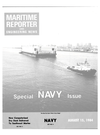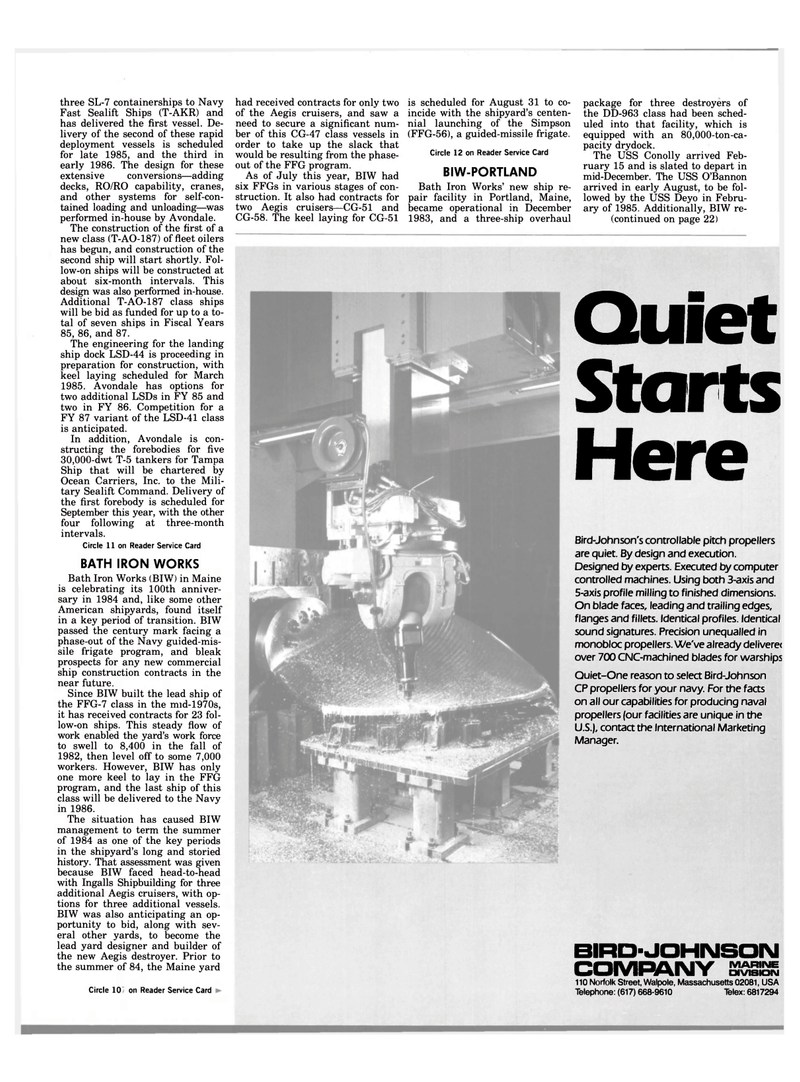
Page 19: of Maritime Reporter Magazine (August 15, 1984)
Read this page in Pdf, Flash or Html5 edition of August 15, 1984 Maritime Reporter Magazine
three SL-7 containerships to Navy
Fast Sealift Ships (T-AKR) and has delivered the first vessel. De- livery of the second of these rapid deployment vessels is scheduled for late 1985, and the third in early 1986. The design for these extensive conversions—adding decks, RO/RO capability, cranes, and other systems for self-con- tained loading and unloading—was performed in-house by Avondale.
The construction of the first of a new class (T-AO-187) of fleet oilers has begun, and construction of the second ship will start shortly. Fol- low-on ships will be constructed at about six-month intervals. This design was also performed in-house.
Additional T-AO-187 class ships will be bid as funded for up to a to- tal of seven ships in Fiscal Years 85, 86, and 87.
The engineering for the landing ship dock LSD-44 is proceeding in preparation for construction, with keel laying scheduled for March 1985. Avondale has options for two additional LSDs in FY 85 and two in FY 86. Competition for a
FY 87 variant of the LSD-41 class is anticipated.
In addition, Avondale is con- structing the forebodies for five 30,000-dwt T-5 tankers for Tampa
Ship that will be chartered by
Ocean Carriers, Inc. to the Mili- tary Sealift Command. Delivery of the first forebody is scheduled for
September this year, with the other four following at three-month intervals.
Circle 11 on Reader Service Card
BATH IRON WORKS
Bath Iron Works (BIW) in Maine is celebrating its 100th anniver- sary in 1984 and, like some other
American shipyards, found itself in a key period of transition. BIW passed the century mark facing a phase-out of the Navy guided-mis- sile frigate program, and bleak prospects for any new commercial ship construction contracts in the near future.
Since BIW built the lead ship of the FFG-7 class in the mid-1970s, it has received contracts for 23 fol- low-on ships. This steady flow of work enabled the yard's work force to swell to 8,400 in the fall of 1982, then level off to some 7,000 workers. However, BIW has only one more keel to lay in the FFG program, and the last ship of this class will be delivered to the Navy in 1986.
The situation has caused BIW management to term the summer of 1984 as one of the key periods in the shipyard's long and storied history. That assessment was given because BIW faced head-to-head with Ingalls Shipbuilding for three additional Aegis cruisers, with op- tions for three additional vessels.
BIW was also anticipating an op- portunity to bid, along with sev- eral other yards, to become the lead yard designer and builder of the new Aegis destroyer. Prior to the summer of 84, the Maine yard
Circle 140 on Reader Service Card 21 had received contracts for only two of the Aegis cruisers, and saw a need to secure a significant num- ber of this CG-47 class vessels in order to take up the slack that would be resulting from the phase- out of the FFG program.
As of July this year, BIW had six FFGs in various stages of con- struction. It also had contracts for two Aegis cruisers—CG-51 and
CG-58. The keel laying for CG-51 is scheduled for August 31 to co- incide with the shipyard's centen- nial launching of the Simpson (FFG-56), a guided-missile frigate.
Circle 12 on Reader Service Card
BIW-PORTLAND
Bath Iron Works' new ship re- pair facility in Portland, Maine, became operational in December 1983, and a three-ship overhaul package for three destroyers of the DD-963 class had been sched- uled into that facility, which is equipped with an 80,000-ton-ca- pacity drydock.
The USS Conolly arrived Feb- ruary 15 and is slated to depart in mid-December. The USS O'Bannon arrived in early August, to be fol- lowed by the USS Deyo in Febru- ary of 1985. Additionally, BIW re- (continued on page 22)
Quiet
Starts
Here
Bird-Johnson's controllable pitch propellers are quiet. By design and execution.
Designed by experts. Executed by computer controlled machines. Using both 3-axis and 5-axis profile milling to finished dimensions.
On blade faces, leading and trailing edges, flanges and fillets. Identical profiles. Identical sound signatures. Precision unequalled in monobloc propellers. We've already delivere< over 700 CNC-machined blades for warships
Quiet-One reason to select Bird-Johnson
CP propellers for your navy. For the facts on all our capabilities for producing naval propellers (our facilities are unique in the
U.S.), contact the International Marketing
Manager.
BIRD-JOHNSON
COMPANY ES5K5 110 Norfolk Street, Walpole, Massachusetts 02081, USA
Telephone: (617) 668-9610 Telex: 6817294

 18
18

 20
20
